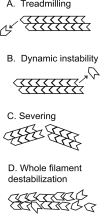Mechanisms of actin disassembly
- PMID: 23900650
- PMCID: PMC3727922
- DOI: 10.1091/mbc.E12-09-0694
Mechanisms of actin disassembly
Abstract
The actin cytoskeleton is constantly assembling and disassembling. Cells harness the energy of these turnover dynamics to drive cell motility and organize cytoplasm. Although much is known about how cells control actin polymerization, we do not understand how actin filaments depolymerize inside cells. I briefly describe how the combination of imaging actin filament dynamics in cells and using in vitro biochemistry progressively altered our views of actin depolymerization. I describe why I do not think that the prevailing model of actin filament turnover--cofilin-mediated actin filament severing--can account for actin filament disassembly detected in cells. Finally, I speculate that cells might be able to tune the mechanism of actin depolymerization to meet physiological demands and selectively control the stabilities of different actin arrays.
Figures

Similar articles
-
Quantitative Variations with pH of Actin Depolymerizing Factor/Cofilin's Multiple Actions on Actin Filaments.Biochemistry. 2019 Jan 8;58(1):40-47. doi: 10.1021/acs.biochem.8b01001. Epub 2018 Dec 18. Biochemistry. 2019. PMID: 30499293 Free PMC article.
-
Minimal requirements for actin filament disassembly revealed by structural analysis of malaria parasite actin-depolymerizing factor 1.Proc Natl Acad Sci U S A. 2011 Jun 14;108(24):9869-74. doi: 10.1073/pnas.1018927108. Epub 2011 May 31. Proc Natl Acad Sci U S A. 2011. PMID: 21628589 Free PMC article.
-
Coordination of the filament stabilizing versus destabilizing activities of cofilin through its secondary binding site on actin.Cytoskeleton (Hoboken). 2014 Jun;71(6):361-79. doi: 10.1002/cm.21178. Epub 2014 Jun 23. Cytoskeleton (Hoboken). 2014. PMID: 24943913 Free PMC article.
-
Biophysics of actin filament severing by cofilin.FEBS Lett. 2013 Apr 17;587(8):1215-9. doi: 10.1016/j.febslet.2013.01.062. Epub 2013 Feb 5. FEBS Lett. 2013. PMID: 23395798 Free PMC article. Review.
-
Mechanism of depolymerization and severing of actin filaments and its significance in cytoskeletal dynamics.Int Rev Cytol. 2007;258:1-82. doi: 10.1016/S0074-7696(07)58001-0. Int Rev Cytol. 2007. PMID: 17338919 Review.
Cited by
-
Actin-interacting Protein 1 Promotes Disassembly of Actin-depolymerizing Factor/Cofilin-bound Actin Filaments in a pH-dependent Manner.J Biol Chem. 2016 Mar 4;291(10):5146-56. doi: 10.1074/jbc.M115.713495. Epub 2016 Jan 8. J Biol Chem. 2016. PMID: 26747606 Free PMC article.
-
The Role of ADF/Cofilin in Synaptic Physiology and Alzheimer's Disease.Front Cell Dev Biol. 2020 Nov 12;8:594998. doi: 10.3389/fcell.2020.594998. eCollection 2020. Front Cell Dev Biol. 2020. PMID: 33282872 Free PMC article. Review.
-
Rapid and effective preparation of clonal bone marrow-derived mesenchymal stem/stromal cell sheets to reduce renal fibrosis.Sci Rep. 2023 Mar 17;13(1):4421. doi: 10.1038/s41598-023-31437-7. Sci Rep. 2023. PMID: 36932137 Free PMC article.
-
Disassembly of bundled F-actin and cellular remodeling via an interplay of Mical, cofilin, and F-actin crosslinkers.Proc Natl Acad Sci U S A. 2023 Sep 26;120(39):e2309955120. doi: 10.1073/pnas.2309955120. Epub 2023 Sep 19. Proc Natl Acad Sci U S A. 2023. PMID: 37725655 Free PMC article.
-
Effect of the Rho-Kinase/ROCK Signaling Pathway on Cytoskeleton Components.Genes (Basel). 2023 Jan 20;14(2):272. doi: 10.3390/genes14020272. Genes (Basel). 2023. PMID: 36833199 Free PMC article. Review.
References
-
- Aizawa H, et al. Phosphorylation of cofilin by LIM-kinase is necessary for semaphorin 3A-induced growth cone collapse. Nat Neurosci. 2001;4:367–373. - PubMed
-
- Andrianantoandro E, Pollard TD. Mechanism of actin filament turnover by severing and nucleation at different concentrations of ADF/cofilin. Mol Cell. 2006;24:13–23. - PubMed
-
- Bamburg JR. Proteins of the ADF/cofilin family: essential regulators of actin dynamics. Annu Rev Cell Dev Biol. 1999;15:185–230. - PubMed
-
- Baum B, Perrimon N. Spatial control of the actin cytoskeleton in Drosophila epithelial cells. Nat Cell Biol. 2001;3:883–890. - PubMed
-
- Bengtsson T, Jaconi ME, Gustafson M, Magnusson KE, Theler JM, Lew DP, Stendahl O. Actin dynamics in human neutrophils during adhesion and phagocytosis is controlled by changes in intracellular free calcium. Eur J Cell Biol. 1993;62:49–58. - PubMed
MeSH terms
Substances
Grants and funding
LinkOut - more resources
Full Text Sources
Other Literature Sources

